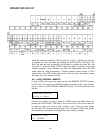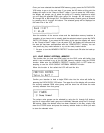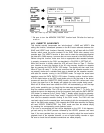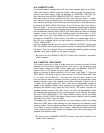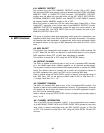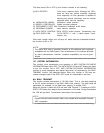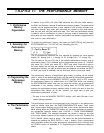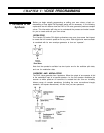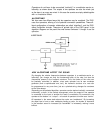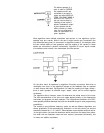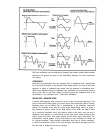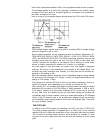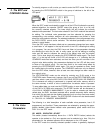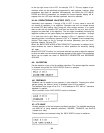
CHAPTER IV: THE PERFORMANCE MEMORY
1. Performance
Memory
Organization
2. Accessing the
Performance
Memory
3. Programming the
Performance
Memory
4. The Performance
Name
In addition to the DX21’s 32 voice RAM memories and 128-voice ROM memory,
the DX21 also features a special 32 performance memory system. This performance
memory can be programmed with a voice number or pair of voice numbers (one
from each channel), play mode, split mode split key number or dual mode detune
data, key shift data, and pitch bend mode data. Thus, when one performance memory
is called a voice or combination of voices in any play mode is automatically called
along with the most important real-time performance parameters programmed for
that voice or voice combination.
To access the performance memory, hold down the FUNCTION key and press the
EDIT/COMPARE key. The LCD will look something like this:
The 32 performance memories are then selected by pressing the voice selector
buttons (A1 through A16 = 1 through 16, B1 through B16 = 17 through 32).
The first data on the top LCD line is the selected performance memory and its
performance name. This is followed by the programmed play mode: SI = SINGLE
play mode, DU = DUAL play mode, SP
= SPLIT play mode. From left to right on
the lower display line we have the number of the voice or voices selected by this
performance memory, the split or detune data (this depends on whether the SPLIT
or DUAL play mode is selected), the key shift data, and the pitch bend mode.
The performance memory is programmed quite simply by setting up the desired
voice or voices in the desired play mode, with the desired performance parameters.
Then, after making sure the MEMORY PROTECT function (A16) is OFF, access
the performance memory by holding down the FUNCTION button and pressing
the EDIT/COMPARE button. Now you can store the currently set up performance
combination in any memory location by holding down the STORE button and
pressing the performance memory selector button to which you wish to save the
performance data. Before you do this, however, you might want to give your
performance combination a name.
** Be sure to turn the MEMORY PROTECT function (A16) back ON after a suc-
cessful storage operation.
The performance name can be programmed at any time while in the performance
mode as follows. Hold down the FUNCTION/CHARACTER button. You’ll notice
that a cursor begins flashing over the first letter of the current performance name.
While holding down the CHARACTER button you can enter characters by pressing
the appropriate character buttons (see CHAPTER V: VOICE PROGRAMMING,
B16: VOICE NAME). The available characters are printed in white on the right
of the voice selector buttons and the buttons to the left of the LCD. Pressing the
PLAY SINGLE button inputs a space.
The cursor can be moved backwards or
forwards by pressing the DATA ENTRY +1 and -1 buttons. Once a performance
name has been entered the entire performance combination must be stored using
the STORE function, as described in "3. Programming the Performance Memory”,
above.
22





